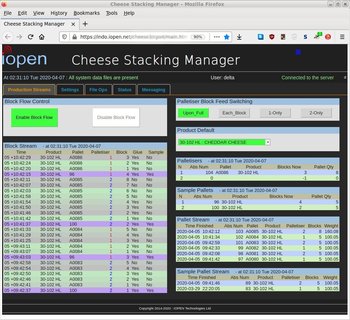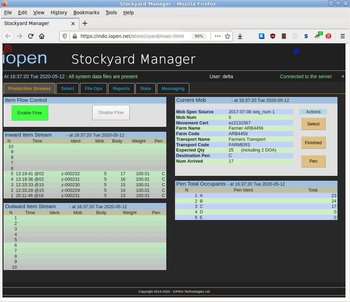The following are Indo / IWAS implementations of production processing encountered earlier elsewhere.
We call them hybrid SCADA systems because they interact with monitoring and control systems to varying degreees.
They are all based on a single underlying structure. Because of how powerful that structure is, creating applications for other production streams is straightforward.

A stream of 20kg blocks of cheese is transported by conveyors to two robots which stack blocks on pallets.
The Management System interfaces with a PLC to control where each block gets sent, and to receive notification of when an incoming block is approaching a barcode reader.
It also prints text on some blocks by sending data to an industrial inkjet printer.
It keeps track of how many blocks are on each pallet, and each time a pallet becomes full it prints a label for the pallet that contains the details of what's on the pallet.
It's also capable of diverting to an 'error' queue any block that either can't be identified or is not an acceptable type.
We've created a simulated environment for this application to run in, so it can be seen operating. Because of the operator interactions, if you want to explore it then you'll need to request access, as for our Demonstration Live System. Details here.

Details of the day's expected arrivals can either be created via the system's editor or via uploading a simple plain-text file to the system.
The application expects to receive data from a tag reader on the input race. And each time it gets one it stores it and increments the appropriate pen total.
It assumes there is a PLC that controls the input race gate and the pen input gates in response to signals it sends.
The application monitoring the exit race(s) sends it the tag value of each exiting animal, and for each of them this application decrements the appropriate pen total.
We've created a simulated environment for this application to run in, so it can be seen operating. Because of the operator interactions, if you want to explore it then you'll need to request access, as for our Demonstration Live System. Details here.
Carcases (or sides) are transported by a chain. As they approach the station the operator inspects them and assigns faults as necessary.
The operator can tell the system to detain an item. When that item approaches the diverter the system tells an associated PLC to divert it into the Detain Queue.
Items in the Detain Queue can either be returned to the main chain (after suitable adjustment), or further diverted to the Condemn chain.
We've created a simulated environment for this application to run in, so it can be seen operating. Because of the operator interactions, if you want to explore it then you'll need to request access, as for our Demonstration Live System. Details here.